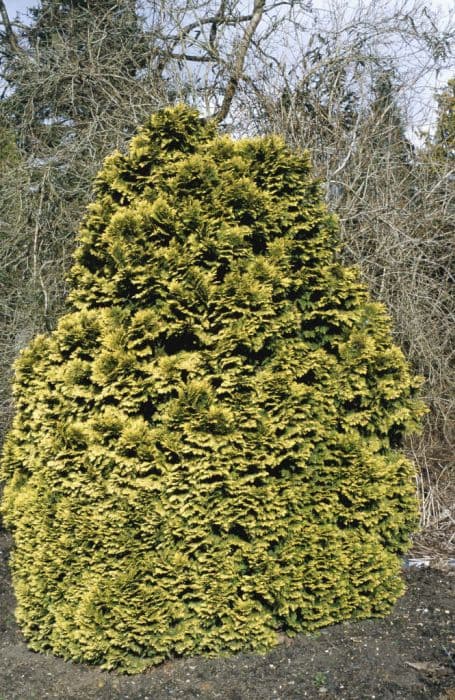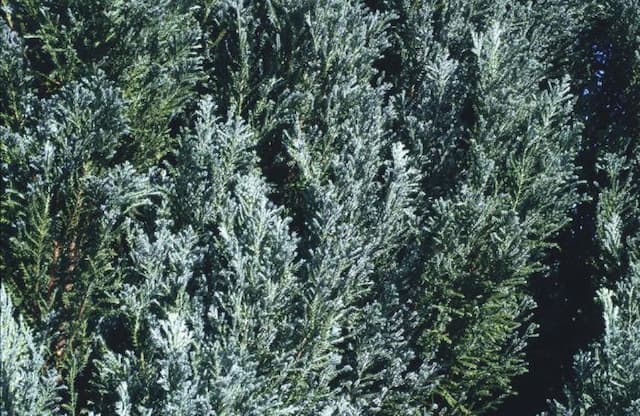Blue Star Juniper Juniperus squamata 'Blue Star'

ABOUT
The 'Blue Star' juniper, also commonly known as Flaky Juniper, has a distinctive appearance characterized by its attractive silver-blue foliage. This evergreen conifer presents itself in a compact, rounded form, densely covered with prickly, needle-like leaves. These leaves are short and arranged in clusters, giving the shrub a somewhat tufted, textured look that is reminiscent of stars, hence the cultivar name 'Blue Star'. The intense blue color provides a stunning contrast to other plants in a landscape setting. As the seasons change, the blue foliage may take on a slightly purplish hue in colder weather, adding to the plant's visual interest throughout the year. Younger plants can exhibit a more pronounced silvery-blue coloration that matures and deepens over time. The overall impression of the 'Blue Star' juniper is one of a serene and frosty aesthetic, making it a favored choice for gardeners looking to inject a cool-toned element into their garden palette.
About this plant
 Names
NamesFamily
Cupressaceae
Synonyms
Blue Star Juniper, Flaky Juniper, Himalayan Juniper
Common names
Juniperus squamata 'Blue Star'.
 Toxicity
ToxicityTo humans
The Blue Star Juniper is generally not considered poisonous to humans; however, ingesting parts of the plant, particularly the berries, may cause intestinal discomfort and other digestive issues such as stomach pain, nausea, vomiting, and diarrhea. Although it is not commonly associated with severe toxicity in humans, it is advisable to avoid eating any part of the Blue Star Juniper.
To pets
The Blue Star Juniper may pose more of a risk to pets, especially if they ingest a significant amount of the plant. While it is not typically fatal, consumption can cause mild gastrointestinal upset in pets such as vomiting or diarrhea. It is recommended to keep an eye on your pet and consult with a veterinarian if you suspect they have ingested parts of the plant, especially in large amounts.
 Characteristics
CharacteristicsLife cycle
Perennials
Foliage type
Evergreen
Color of leaves
Blue
Height
1-2 feet (0.3-0.6 meters)
Spread
2-4 feet (0.6-1.2 meters)
Plant type
Shrub
Hardiness zones
4-8
Native area
Asia
Benefits
 General Benefits
General Benefits- Drought Tolerance: Juniperus squamata 'Blue Star' is highly drought-resistant, making it ideal for xeriscaping and low-water gardens.
- Low Maintenance: This plant requires minimal care, as it is pest resistant and does not need regular pruning.
- Year-Round Interest: With its striking blue-gray foliage, the Blue Star Juniper provides visual appeal throughout all seasons.
- Cold Hardy: It can withstand cold temperatures, making it suitable for gardens in cooler climates.
- Ground Cover: Its low-growing, spreading habit makes it an excellent ground cover option to prevent soil erosion.
- Wildlife Habitat: While not a major attractant, it can provide shelter for small wildlife and birds in the garden.
- Architectural Interest: Its unique shape and texture provide great visual interest for rock gardens, borders, and containers.
- Evergreen Foliage: As an evergreen, it retains its needles year-round, ensuring there’s always greenery in the garden even in winter.
 Medical Properties
Medical PropertiesThis plant is not used for medical purposes.
 Air-purifying Qualities
Air-purifying QualitiesThis plant is not specifically known for air purifying qualities.
 Other Uses
Other Uses- Juniper 'Blue Star' can be used in miniature gardens or fairy gardens because of its compact size and interesting texture, offering an enchanting landscape to small-scale settings.
- The aromatic foliage of Juniper 'Blue Star' can be used to make potpourris, imparting a fresh, woodsy scent to your home decor.
- Drought-tolerant landscape designs often incorporate Juniper 'Blue Star' to reduce water usage while providing year-round color and ground coverage.
- This plant can serve as a safe haven for beneficial insects and small wildlife, such as birds, which may use it for nesting and shelter.
- Bonsai enthusiasts may choose Juniper 'Blue Star' for its adaptability and attractive blue-green foliage to create stunning miniature trees.
- Juniper 'Blue Star' can be used as a natural fencing or border when planted in a row, providing a low-maintenance alternative to traditional fencing materials.
- In coastal areas, Juniper 'Blue Star' is useful for stabilizing sand dunes and slopes, thanks to its extensive root system and tolerance of salt spray.
- The dense growth habit of Juniper 'Blue Star' is ideal for creating intricate garden mazes or low hedges for aesthetic and recreational garden design.
- During the holiday season, branches of Juniper 'Blue Star' might be harvested and used as part of natural wreath arrangements or as greenery in festive decorations.
- Photographers and artists may use the distinct form and color of Juniper 'Blue Star' as a subject or as a backdrop for nature-inspired compositions and works of art.
Interesting Facts
 Feng Shui
Feng ShuiThe Blue Star Juniper is not used in Feng Shui practice.
 Plant Symbolism
Plant Symbolism- Protection: Junipers are often associated with protection, as they were used historically to ward off evil spirits and illnesses.
- Cleansing: With their fresh, clean scent, Blue Star Junipers symbolize cleansing and purification.
- Longevity: Junipers are known for their long lifespan, and the Blue Star variety symbolizes endurance and the ability to thrive in harsh conditions.
- Healing: In some traditions, Junipers are connected to healing rituals, and the Blue Star Juniper can be seen as a symbol of health and recovery.
 Water
WaterThe Blue Star Juniper should be watered regularly but cautiously, ensuring the soil is not allowed to dry out completely nor become waterlogged. Typically, watering every 7 to 10 days is sufficient, depending on the climate and soil drainage. The method involves deep watering to encourage the roots to grow downward; apply approximately 1-2 gallons per plant for each watering session. During hot, dry periods, increase the frequency to prevent stress, especially in the first growing season after planting to establish a strong root system.
 Light
LightThe Blue Star Juniper thrives best in full sun conditions. It should be placed in a location where it can receive at least 6 hours of direct sunlight daily. An ideal spot would be in a landscape that is open to the sky and not shaded by larger trees or structures.
 Temperature
TemperatureThe Blue Star Juniper is hardy and can tolerate a wide range of temperatures, withstanding lows down to -10 degrees Fahrenheit and highs well over 100 degrees Fahrenheit. The ideal temperature range for optimal growth is between 60 and 80 degrees Fahrenheit, but it can survive outside of this range once well-established.
 Pruning
PruningThe Blue Star Juniper typically requires minimal pruning, intended primarily to maintain its compact, rounded shape or to remove any dead or damaged branches. Pruning is best done in late winter or early spring before new growth starts. Annual light pruning is often sufficient for this slow-growing plant, and more substantial shaping can be done every few years as needed.
 Cleaning
CleaningAs needed
 Soil
SoilBlue Star Juniper thrives best in well-drained, sandy or loamy soils with a pH range of 6.0 to 8.0. A soil mix consisting of 1/3 topsoil, 1/3 sand or perlite, and 1/3 peat or compost will provide a suitable environment for this plant to grow, ensuring good drainage and aeration.
 Repotting
RepottingBlue Star Junipers are slow-growing and do not require frequent repotting. They should be repotted every 3 to 5 years or when the plant outgrows its current pot. Always use fresh soil mix when repotting to provide the plant with new nutrients.
 Humidity & Misting
Humidity & MistingBlue Star Juniper prefers outdoor environments and tolerates a wide range of humidity levels well. It is not particular about humidity and can thrive in average outdoor conditions where the humidity naturally fluctuates.
 Suitable locations
Suitable locationsIndoor
Ensure bright light, adequate water, and good air circulation.
Outdoor
Plant in full sun, well-drained soil, and space adequately.
Hardiness zone
4-8 USDA
 Life cycle
Life cycleThe life of the Blue Star Juniper begins with seed germination, occurring when conditions of warmth and moisture induce a seed to sprout, producing a small seedling. As the seedling grows, it enters a juvenile vegetative state where it develops a sturdy root system and foliage but does not yet reproduce. Transitioning to maturity, it starts developing cones; the male cones release pollen, while female cones develop into berries that contain seeds, marking the reproductive stage. After pollination and fertilization, seeds are dispersed, often by birds or wind, into a suitable environment for the next generation to grow. The Blue Star Juniper, being a slow-growing evergreen, may go through this reproductive cycle many times over its life span of several decades. Throughout its life, the plant experiences periodic growth in size and density, with the iconic blue-tinged foliage becoming more prominent as it matures.
 Propogation
PropogationPropogation time
Spring-Early Summer
The Juniperus squamata 'Blue Star', commonly known as Blue Star Juniper, is typically propagated through softwood cuttings. This method is most effectively carried out during the late spring or early summer when new growth is soft and green. To propagate, a cutting of about 4 to 6 inches (10 to 15 cm) is taken from a healthy branch, making sure it has several sets of leaves. The lower leaves are removed, and the cut end is dipped in a rooting hormone to stimulate root growth. The cutting is then planted in a pot filled with a well-draining soil mix and kept moist. It is beneficial to cover the pot with a plastic bag or place it in a propagator to maintain high humidity levels around the cutting, which helps encourage rooting. Roots will generally begin to develop within several weeks, after which the new Blue Star Juniper plant can be gradually acclimatized to less humid conditions before being planted out.









